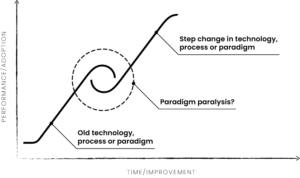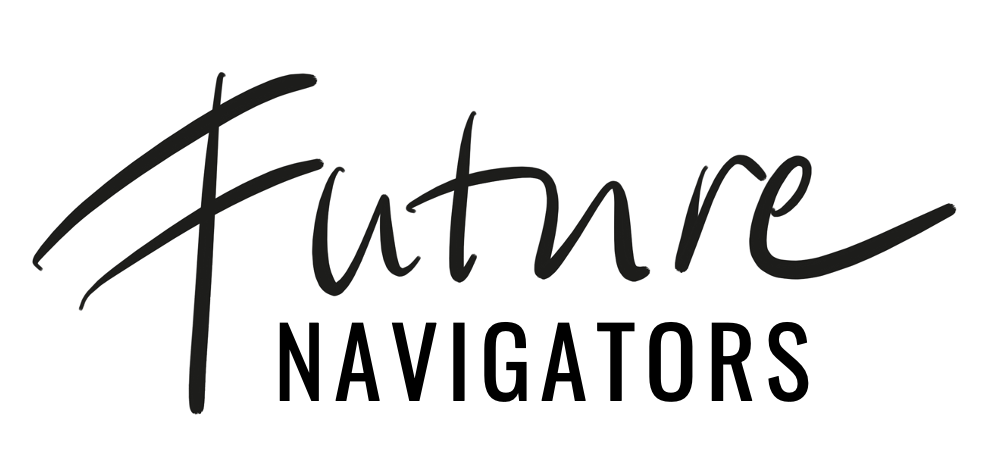Are you stuck in a paradigm paralysis?

"All truth passes through three stages.
First, it is ridiculed.
Second, it is violently opposed.
Third, it is accepted as self-evident."
-Arthur Schopenhauer
Change and disruption may seem to be new characteristics related to our modern world but are in fact not new phenomenon. They have been with us since the beginning of time, and some patterns seem to be repeated continuously.
Following her studies of change throughout human history, Connie Gersick described what change as a pattern has looked like throughout history on a multitude of different levels—from organisms to organizations and civilizations. The identified change pattern is characterized by long periods of stability where existing systems and structures prevent change, followed by periods of revolutionary change where the prevailing systems and structures are broken up and replaced.
Hence, systems and structures provide stability as well as rigidity but can only prevent change for limited periods of time until the external pressure to change and adapt becomes so large that the system is torn apart during a more chaotic and revolutionary period of time. This period is again followed by a new period of stability and then a period of revolutionary change. And so on. Throughout time. Interestingly, this is similar to the S-curve of innovation first described by Everett Rogers in the 1960s, which is how academics describe paradigm shifts (see the figure below).
Each curve on the S-curve can be said to represent a generation of technology, idea or way of thinking—or simply a new paradigm.
 Figure. The S-curve of innovation - and the paradigm paralysis that can appear between two curves, from Better Business Better Future by Elisabet Lagerstedt (2022), p72
Figure. The S-curve of innovation - and the paradigm paralysis that can appear between two curves, from Better Business Better Future by Elisabet Lagerstedt (2022), p72As the dominating way of thinking and doing things ages, it can best be described as gradually losing its relevance. At one point or the other (when its relevance, usefulness or competitive advantage has been eroded), it is then replaced with a new generation of technology, or a new way of thinking resulting in a new S-curve. How does this work?
As a paradigm grows and matures, different alternatives—new ideas, technologies and ways of thinking—pop up. Some never spread or gain traction in relevant parts of society, but some do—even though they tend to be ridiculed at the outset by those representing the dom- inating paradigm. As Arthur Schopenhauer famously put it, “All truth passes through three stages. First, it is ridiculed. Second, it is violently opposed. Third, it is accepted as self-evident.” Hence, what is today evident was not so evident just a few decades ago and will not be so evident in another few decades from now.
Again, for an idea to evolve into a new paradigm, it needs to gain traction in relevant parts of society. And as the old pattern of thinking reaches maturity, it sooner or later starts to collapse. In parallel, however, isolated alternatives have slowly begun to arise and give way to the new ideas, practices and/or technologies that are evolving by those exploring and pioneering the future. This new curve develops slowly in the early beginnings, accelerates quickly, matures and, finally, stabilizes and comes to a flattening and decline of the curve, as it is again replaced by a new paradigm—i.e., new ideas, practices and/or technologies.
The process in which the dominant paradigm gives way to new paradigms to emerge and grow is simply called a paradigm shift, which is “an important change that happens when the usual way of thinking about or doing something is replaced by a new and different way”.
Paradigm paralysis can then best be described as being ‘stuck in the middle’ between the old thought pattern and the new one that is trying to emerge, especially when the new pattern is not completely clear yet.
What if this describes our current situation? The new is emerging, but we still seem to be stuck in the past view of ‘how things are done’. Let us imagine that we are evolving from a maturing and declining paradigm where the sole purpose of business is to create and maximise its short-term profits, into a new paradigm where long-term stakeholder value and more sustainable (and even regenerative) business practices seem to be the cornerstones of the new dominating thought system. In this development, a sense of being stuck in the middle — in paradigm paralysis — is, in my experience, what many business leaders currently experience as they stumble on the edge between the old paradigm and the emerging future (see the figure below).
 Figure. The old and evolving business paradigms, and the paralysis that can appear in feeling stuck in the middle, with both new and old practices and mindsets co-existing at the same time. From Better Business Better Future, by Elisabet Lagerstedt (2022), p73
Figure. The old and evolving business paradigms, and the paralysis that can appear in feeling stuck in the middle, with both new and old practices and mindsets co-existing at the same time. From Better Business Better Future, by Elisabet Lagerstedt (2022), p73This is, of course, especially challenging for business leaders who have been “brought up” and fostered in the old paradigm and see a huge gap between the old and the new. The good news is that even those stumbling between the different paradigms have a lot to learn from those companies and business leaders who are already in the frontlines.
What about you? Do you feel stuck in business as usual? And what do you feel hinders you in adopting a new mindset and an updated set of practices?
Read more in Better Business Better Future, by Elisabet Lagerstedt, 2022, where all sources and references for this article are available in the endnotes.
I invite you to explore the Better Business Acceleration Program™. As current and future business leaders, we can go far beyond demonstrating in the streets. We can move ideas, minds, capital and business models - and cooperate to nudge consumers into making better choices. Everything to co-create the healthy future that we want for our business, the planet and the generations to come. Do you yearn to contribute, and become future-fit in the process? Then this is the online program for you!

